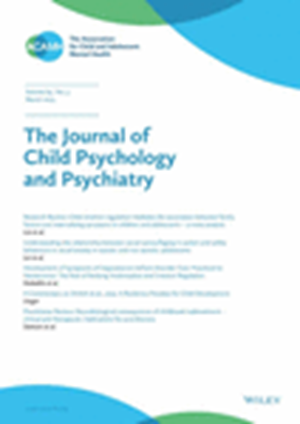Predicting adolescent disordered eating and behaviours: exploring environmental moderators of polygenic risk.
IF 7
1区 医学
Q1 PSYCHIATRY
引用次数: 0
Abstract
BACKGROUND Both genetic and environmental factors contribute to the risk of developing disordered eating, with twin studies demonstrating environmental factors moderate genetic susceptibility. To date, gene-environment interactions leveraging polygenic risk scores (PRS) have not been studied in disordered eating phenotypes beyond anorexia nervosa (AN). This study investigated if polygenic risk for AN interacts with established environmental eating disorder risk factors (parental expectations, parental criticism, parental conflict, parental care and weight-related peer teasing) to predict overall levels of disordered eating in the general population or specific lifetime disordered eating behaviours (avoidance of eating, objective bulimic episodes, self-induced vomiting and driven exercise). METHODS PRS were calculated using summary statistics from the largest AN genome-wide association study. Environmental factors were assessed via telephone interview using standardized measures. Analyses were performed using genome-wide complex trait analysis to test whether parental expectations, criticism, conflict or care, or weight-related peer teasing interacted with AN PRS to predict disordered eating outcomes in our sample (n = 383). RESULTS The analyses revealed significant main effects of parental expectations, parental criticism, parental care, and weight-related peer teasing on at least one disordered eating outcome. All environmental variables moderated the association between AN PRS and at least one disordered eating outcome by either increasing risk (parental expectations, parental criticism, parental conflict, weight-related peer teasing) or lowering risk (parental care). CONCLUSIONS Findings highlight the complex interplay between genetic and environmental factors in disordered eating development and emphasize the importance of personalized interventions that consider both genetic predisposition and environmental influences.预测青少年饮食失调和行为:探索多基因风险的环境调节因子。
背景遗传和环境因素都对饮食失调的风险有影响,双胞胎研究表明环境因素对遗传易感性有调节作用。迄今为止,利用多基因风险评分(PRS)的基因-环境相互作用尚未在神经性厌食症(AN)以外的饮食失调表型中进行研究。本研究调查了AN的多基因风险是否与既定的环境饮食失调风险因素(父母期望、父母批评、父母冲突、父母照顾和体重相关的同伴戏弄)相互作用,以预测一般人群饮食失调的总体水平或特定的终生饮食失调行为(避免进食、客观暴食症发作、自我诱导呕吐和驱动运动)。方法利用最大的AN全基因组关联研究的汇总统计数据计算sprs。环境因素通过电话访谈采用标准化措施进行评估。使用全基因组复杂性状分析进行分析,以测试父母的期望、批评、冲突或关心,或体重相关的同伴戏弄是否与AN PRS相互作用,以预测我们样本中的饮食失调结果(n = 383)。结果分析显示,父母期望、父母批评、父母照顾和体重相关的同伴戏弄对至少一种饮食失调的结果有显著的主要影响。所有环境变量通过增加风险(父母期望、父母批评、父母冲突、体重相关的同伴戏弄)或降低风险(父母照顾)来调节AN PRS与至少一种饮食失调结果之间的关联。结论研究结果强调了进食障碍发展中遗传和环境因素之间复杂的相互作用,并强调了考虑遗传易感性和环境影响的个性化干预的重要性。
本文章由计算机程序翻译,如有差异,请以英文原文为准。
求助全文
约1分钟内获得全文
求助全文
来源期刊
CiteScore
13.80
自引率
5.30%
发文量
169
审稿时长
1 months
期刊介绍:
The Journal of Child Psychology and Psychiatry (JCPP) is a highly regarded international publication that focuses on the fields of child and adolescent psychology and psychiatry. It is recognized for publishing top-tier, clinically relevant research across various disciplines related to these areas. JCPP has a broad global readership and covers a diverse range of topics, including:
Epidemiology: Studies on the prevalence and distribution of mental health issues in children and adolescents.
Diagnosis: Research on the identification and classification of childhood disorders.
Treatments: Psychotherapeutic and psychopharmacological interventions for child and adolescent mental health.
Behavior and Cognition: Studies on the behavioral and cognitive aspects of childhood disorders.
Neuroscience and Neurobiology: Research on the neural and biological underpinnings of child mental health.
Genetics: Genetic factors contributing to the development of childhood disorders.
JCPP serves as a platform for integrating empirical research, clinical studies, and high-quality reviews from diverse perspectives, theoretical viewpoints, and disciplines. This interdisciplinary approach is a key feature of the journal, as it fosters a comprehensive understanding of child and adolescent mental health.
The Journal of Child Psychology and Psychiatry is published 12 times a year and is affiliated with the Association for Child and Adolescent Mental Health (ACAMH), which supports the journal's mission to advance knowledge and practice in the field of child and adolescent mental health.

 求助内容:
求助内容: 应助结果提醒方式:
应助结果提醒方式:


